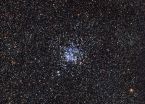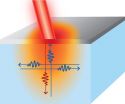(Press-News.org) A new study from North Carolina State University sheds light on how some collegiate student-athletes deal with uncertainties ranging from excelling in both school and sports to their career prospects outside of athletics, and urges university athletic programs to adopt new efforts to support student-athletes.
"We wanted to explore how student-athletes at top-tier universities cope with the dual challenges of meeting the expectations of their teams while simultaneously complying with their responsibilities as university students," says Dr. Lynsey Romo, an assistant professor of communication at NC State and lead author of a paper on the work.
The study was based on in-depth interviews with 17 student-athletes at a university that is considered to be "elite" in both its academic and athletic programs.
"This is a qualitative study, so we can't generalize these findings to all college athletes,"Romo says. "But it's highly likely that universities with both high-level academics and athletics can use this information to examine their own programs and explore possible services for their student-athletes."
The researchers found that student-athletes reported feeling uncertain in three areas: personal uncertainty, such as uncertainty about balancing school work and sports; social uncertainty, such as uncertainty related to who their "real" friends are; and future uncertainty, such as uncertainty concerning their post-collegiate careers and whether the time they spend pursuing athletics will hurt their career prospects.
Most of the student-athletes reported using a variety of techniques to reduce uncertainty. These uncertainty-reduction strategies included seeking social support from friends, family, or academic counselors; socializing with friends to take a break from sports and school pressures; negotiating with coaches in an attempt to raise their scholarship; and sometimes concealing their athlete status from peers to minimize people befriending them for the wrong reasons, or prevent negative stereotypes. Other student-athletes came to terms with uncertainty as a natural part of life and turned to prayer to help them cope.
"Our findings suggest that universities can do more to prepare students for life outside of athletics," Romo says. "For example, athletics departments may be able to work with employers to offer flexible paid or unpaid professional internships around student-athletes' seasons. In this way, student athletes can receive work experience in fields outside of sports.
"In addition," Romo says, "university athletics programs should take steps to give student-athletes more free time – what is sometimes overlooked amidst a heavy athletics and academic schedule is the scholar athletes' need to unwind and decompress. Study participants reported having to make a concerted effort to see family and friends, often at the cost of time that could have been devoted to schoolwork. They need more downtime."
INFORMATION:
The paper, "'You Never Know What's Gonna Happen': An Examination of Communication Strategies Used by College Student-Athletes to Manage Uncertainty," is published online in the journal Communication & Sport. The paper was co-authored by NC State undergraduates Christine Davis and Alyssa Fea.
Study offers insight into challenges facing college athletes
2014-10-01
ELSE PRESS RELEASES FROM THIS DATE:
Novel approach to magnetic measurements atom-by-atom
2014-10-01
Having the possibility to measure magnetic properties of materials at atomic precision is one of the important goals of today's experimental physics. Such measurement technique would give engineers and physicists an ultimate handle over magnetic properties of nano-structures for future applications. In an article published in Physical Review Letters researchers propose a new method, utilizing properties of the quantum world – the phase of the electron beam – to detect magnetism with atom-by-atom precision.
The electron microscope is a fascinating instrument. It uses a ...
Platinum meets its match in quantum dots from coal
2014-10-01
Graphene quantum dots created at Rice University grab onto graphene platelets like barnacles attach themselves to the hull of a boat. But these dots enhance the properties of the mothership, making them better than platinum catalysts for certain reactions within fuel cells.
The Rice lab of chemist James Tour created dots known as GQDs from coal last year and have now combined these nanoscale dots with microscopic sheets of graphene, the one-atom-thick form of carbon, to create a hybrid that could greatly cut the cost of generating energy with fuel cells.
The research ...
Predicting the future course of psychotic illness
2014-10-01
Psychiatry researchers from the University of Adelaide have developed a model that could help to predict a patient's likelihood of a good outcome from treatment - from their very first psychotic episode.
The model is based on a range of factors, including clinical symptoms, cognitive abilities, MRI scans of the brain's structure, and biomarkers in the patient's blood.
Speaking in the lead up to World Mental Health Day (10 October), the University's Head of Psychiatry, Professor Bernhard Baune, says the model is a revolutionary idea for psychiatric care, and is aimed ...
Fat chats: The good, the bad and the ugly comments
2014-10-01
Cyberbullying and hurtful 'fat jokes' are disturbingly prevalent in the social media environment, especially on Twitter, says Wen-ying Sylvia Chou of the National Institutes of Health in the US. Chou is lead author of a study in Springer's journal Translational Behavioral Medicine which analyzed well over a million social media posts and comments about weight matters. However, the researchers were also happy to find that the news was not all bad: many instances of support and advice were also observed, especially on blogs and forums.
The study is one of the first to analyze ...
Fall in monsoon rains driven by rise in air pollution, study shows
2014-10-01
Emissions produced by human activity have caused annual monsoon rainfall to decline over the past 50 years, a study suggests.
In the second half of the 20th century, the levels of rain recorded during the Northern Hemisphere's summer monsoon fell by as much as 10 per cent, researchers say. Changes to global rainfall patterns can have serious consequences for human health and agriculture.
Scientists found that emissions of tiny air particles from man-made sources – known as anthropogenic aerosols – were the cause. High levels of aerosols in the atmosphere cause heat ...
Wild ducks take flight in open cluster
2014-10-01
Messier 11 is an open cluster, sometimes referred to as a galactic cluster, located around 6000 light-years away in the constellation of Scutum (The Shield). It was first discovered by German astronomer Gottfried Kirch in 1681 at the Berlin Observatory, appearing as nothing more than a fuzzy blob through the telescope. It wasn't until 1733 that the blob was first resolved into separate stars by the Reverend William Derham in England, and Charles Messier added it to his famous catalogue in 1764.
Messier was a comet hunter and the catalogue came into being as he was frustrated ...
Gene interacts with stress and leads to heart disease in some people
2014-10-01
DURHAM, N.C. – A new genetic finding from Duke Medicine suggests that some people who are prone to hostility, anxiety and depression might also be hard-wired to gain weight when exposed to chronic stress, leading to diabetes and heart disease.
An estimated 13 percent of people, all of whom are Caucasian, might carry the genetic susceptibility, and knowing this could help them reduce heart disease with simple interventions such as a healthy diet, exercise and stress management.
"Genetic susceptibility, psychosocial stress and metabolic factors act in combination to increase ...
Results of large-scale roll out of combination treatment for kala-azar in Eastern Africa
2014-10-01
Today in Bahir Dar, Ethiopia, at the occasion of the Leishmaniasis East Africa Platform meeting, which has gathered some 150 African and international leishmaniasis experts, results of a pharmacovigilance – or large-scale treatment safety and efficacy monitoring – plan, carried out by MSF, DNDi, and national partners in Kenya, Sudan, Uganda, and Ethiopia, were presented to key decision makers in order to boost patient access to treatment of kala-azar with the combination of Sodium Stibogluconate and Paromomycin (SSG&PM) in the region. In this large cohort of patients, treated ...
Long-acting insulin is safer, more effective for patients with Type 1 diabetes
2014-10-01
TORONTO, Oct. 1, 2014 – Long-acting insulin is safer and more effective than intermediate-acting insulin for patients with Type 1 diabetes, according to new research published in the BMJ.
Researchers looked at once-daily and twice-daily doses of both long- and intermediate-acting insulin, ranking their effectiveness, safety and cost-effectiveness.
"In patients with Type 1 diabetes, we found that long-acting insulin is superior to intermediate-acting insulin when it came to controlling blood sugar, preventing weight gain and treating severe hypoglycemia," said Dr. ...
All directions are not created equal for nanoscale heat sources
2014-10-01
Thermal considerations are rapidly becoming one of the most serious design constraints in microelectronics, especially on submicron scale lengths. A study by researchers from the University of Illinois at Urbana-Champaign has shown that standard thermal models will lead to the wrong answer in a three-dimensional heat-transfer problem if the dimensions of the heating element are on the order of one micron or smaller.
"As materials shrink, the rules governing heat transfer change as well," explained David Cahill, a professor of materials science and engineering at Illinois. ...


